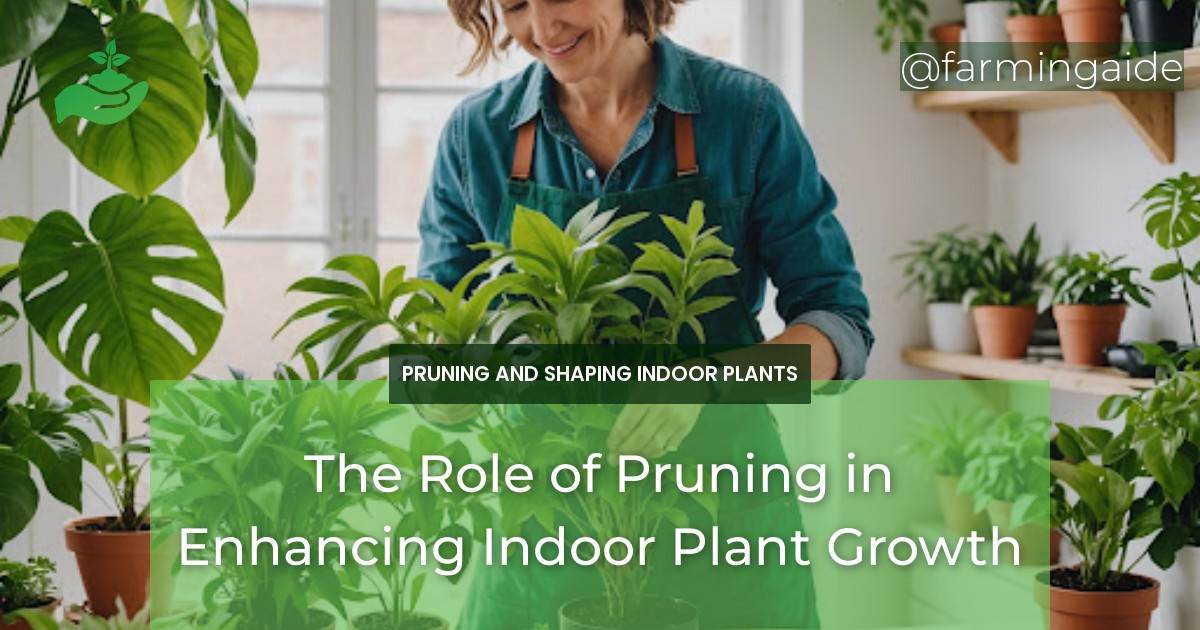As indoor plant enthusiasts, we all strive to create a thriving oasis in our homes, but sometimes our plants may not be reaching their full potential. One crucial aspect of indoor plant care that is often overlooked is pruning. Pruning is an essential technique that not only enhances the aesthetic appeal of your plants but also promotes healthy growth, prevents disease, and encourages blooming. In this comprehensive guide, we’ll delve into the world of pruning for indoor plant growth, exploring the benefits, techniques, and best practices to help you become a pruning pro.
Key Takeaways
- Pruning stimulates healthy growth and encourages blooming in indoor plants.
- Different pruning techniques are required for various plant types.
- Pruning helps control plant size and shape, preventing overcrowding.
- Pruning prevents disease and pest infestation by removing infected areas.
- Regular pruning maintains plant appearance and promotes air circulation.
Understanding Pruning
Definition and Purpose of Pruning
Pruning is the selective removal of certain parts of a plant, such as branches, leaves, or roots, to improve its overall health, appearance, and growth. The purpose of pruning is to direct the plant’s energy towards producing healthy, vigorous growth, rather than expending energy on weak or damaged areas. By pruning, you can control the shape and size of your plant, encourage blooming, and prevent disease.
Pruning is an essential skill for indoor plant care, as it helps maintain the plant’s natural shape, promotes air circulation, and increases the plant’s resistance to disease and pests.
Types of Pruning Techniques
There are several pruning techniques, each with its own purpose and benefits. The most common techniques include:
| Technique | Description |
|---|---|
| Pinching | Removing the growing tip to encourage branching. |
| Thinning | Removing select branches to improve air circulation and reduce density. |
| Heading | Removing the terminal bud to control the direction of growth. |
| Renewal Pruning | Cutting back the entire plant to rejuvenate and stimulate new growth. |
Benefits of Pruning for Indoor Plants
ALSO READ
Stimulating Growth and Health
Pruning stimulates healthy growth by removing weak or damaged areas, allowing the plant to focus its energy on producing vigorous new growth. This, in turn, promotes a stronger, more resilient plant that is better equipped to fight off disease and pests.
Regular pruning also encourages the plant to produce more blooms, as energy is redirected towards flowering. This is especially important for flowering plants, where blooming is a key aspect of their beauty.
Controlling Plant Size and Shape
Pruning helps control the size and shape of your indoor plants, preventing them from becoming leggy or unruly. By removing select branches, you can maintain a desired shape, encourage bushy growth, and prevent overcrowding.
ALSO READ
Preventing Disease and Pest Infestation
Pruning helps prevent disease and pest infestation by removing infected areas, reducing the risk of spreading disease to other parts of the plant. Regular pruning also improves air circulation, reducing the humidity that fosters fungal growth.
When and How to Prune Indoor Plants
Best Times for Pruning
The best time to prune indoor plants depends on the type of plant and its growth cycle. Generally, pruning is best done during the plant’s dormant period or when it’s actively growing. Avoid pruning during periods of stress, such as when the plant is recovering from disease or pests.
Step-by-Step Pruning Guide
Before pruning, gather your tools, including clean, sharp pruning shears or scissors, and a small bowl of water to sanitize your tools between cuts. Identify the areas of the plant that require pruning, taking care not to damage surrounding healthy tissue.
Remove any dead or damaged leaves or branches, making clean cuts just above a node (where a branch meets the stem). Cut at a 45-degree angle, sloping away from the node to prevent water from collecting.
Tools and Safety Precautions
Always use clean, sharp pruning tools to prevent the spread of disease. Sanitize your tools between cuts by dipping them in a bowl of water and then wiping them dry. Wear protective gloves to prevent scratches and injuries.
Common Indoor Plants and Their Pruning Needs
Succulents and Cacti
Succulents and cacti require less pruning due to their slow growth rate. Remove any dead or damaged segments, and trim back overgrown stems to maintain shape.
Fiddle Leaf Figs and Other Popular Houseplants
Fiddle leaf figs and other popular houseplants require regular pruning to maintain their shape and promote healthy growth. Remove any dead or damaged leaves, and trim back long stems to encourage branching.
Flowering Indoor Plants
Flowering indoor plants, such as African violets and begonias, require regular pruning to encourage blooming. Remove spent flowers, and trim back leggy stems to promote bushy growth.
Pruning Mistakes to Avoid
Over-Pruning and Under-Pruning
Avoid over-pruning, as this can cause stress and weaken the plant. Conversely, under-pruning can lead to leggy growth and reduced blooming.
Using Incorrect Tools
Always use clean, sharp pruning tools to prevent the spread of disease. Dull or dirty tools can cause more harm than good, leading to infection and further damage.
Conclusion and Pruning Best Practices
In conclusion, pruning is a vital aspect of indoor plant care, promoting healthy growth, preventing disease, and encouraging blooming. By following the guidelines outlined in this article, you’ll be well on your way to becoming a pruning pro, equipped with the knowledge to keep your indoor plants thriving.
Remember to prune with a purpose, taking into account the type of plant, its growth cycle, and its specific pruning needs. With regular pruning, you’ll be rewarded with vibrant, healthy plants that bring joy and beauty to your home.


